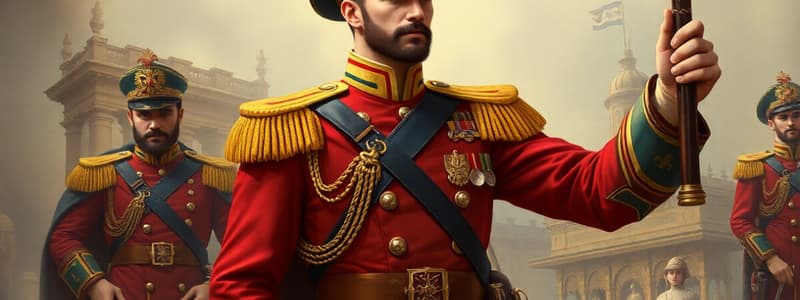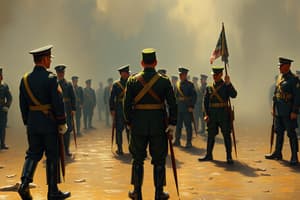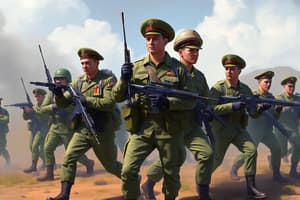Podcast
Questions and Answers
What are two ways subordinate commanders and staffs can assist the commander in making sound decisions?
What are two ways subordinate commanders and staffs can assist the commander in making sound decisions?
- By providing information only when specifically requested by the commander.
- By providing opinions and recommendations on every decision.
- By gathering and presenting information in a clear and useful format. (correct)
- By keeping the commander informed about every detail of operations.
Command presence solely relies on the commander's physical presence on the battlefield.
Command presence solely relies on the commander's physical presence on the battlefield.
False (B)
Why is command considered more of an art than a science?
Why is command considered more of an art than a science?
Command relies heavily on judgment, experience, and intuition, which are not easily quantifiable or standardized like scientific principles.
Commanders establish command presence through ______ with subordinates and by demonstrating their character, competence, dignity, strength of conviction, and empathy.
Commanders establish command presence through ______ with subordinates and by demonstrating their character, competence, dignity, strength of conviction, and empathy.
Match the following leadership qualities to their corresponding descriptions:
Match the following leadership qualities to their corresponding descriptions:
A commander's position on the battlefield has no impact on their ability to influence operations.
A commander's position on the battlefield has no impact on their ability to influence operations.
What is the primary purpose of delegating authority to subordinates?
What is the primary purpose of delegating authority to subordinates?
Explain the importance of a commander's experience in shaping information requirements and staff priorities.
Explain the importance of a commander's experience in shaping information requirements and staff priorities.
What is the primary reason for developing Commander's Critical Information Requirements (CCIRs)?
What is the primary reason for developing Commander's Critical Information Requirements (CCIRs)?
CCIRs remain unchanged throughout an operation.
CCIRs remain unchanged throughout an operation.
What is the term used for information that is unexpected or arises from a new threat, directly impacting the success of operations, and would have been a CCIR if foreseen?
What is the term used for information that is unexpected or arises from a new threat, directly impacting the success of operations, and would have been a CCIR if foreseen?
Developing detailed contingency plans and CCIRs encourages commanders and staffs to be ______ rather than ______ in responding to enemy activity.
Developing detailed contingency plans and CCIRs encourages commanders and staffs to be ______ rather than ______ in responding to enemy activity.
What is the primary benefit of subordinate commanders exercising initiative in Army formations?
What is the primary benefit of subordinate commanders exercising initiative in Army formations?
Commanders should only encourage initiative during training events, not during actual operations.
Commanders should only encourage initiative during training events, not during actual operations.
What are two factors subordinates should consider when deciding how to exercise initiative?
What are two factors subordinates should consider when deciding how to exercise initiative?
The ______ of combat leadership should be shared between leaders at each echelon.
The ______ of combat leadership should be shared between leaders at each echelon.
Match the following terms with their corresponding definitions:
Match the following terms with their corresponding definitions:
Which of the following is NOT a factor that commanders must consider when accepting risk and encouraging initiative?
Which of the following is NOT a factor that commanders must consider when accepting risk and encouraging initiative?
Exercising initiative is always beneficial and should be encouraged in all situations.
Exercising initiative is always beneficial and should be encouraged in all situations.
What are two ways commanders can delegate risk acceptance to subordinates?
What are two ways commanders can delegate risk acceptance to subordinates?
What is a key advantage of the mission command approach to C2, especially during degraded communication?
What is a key advantage of the mission command approach to C2, especially during degraded communication?
Preparing for degraded communications should only begin when communications breakdown or a crisis occurs.
Preparing for degraded communications should only begin when communications breakdown or a crisis occurs.
List three examples of methods to decrease a unit's vulnerability to electromagnetic interference (EMI).
List three examples of methods to decrease a unit's vulnerability to electromagnetic interference (EMI).
During extended communication outages, maintaining a shared understanding of the situation becomes more challenging as the ______ deteriorates.
During extended communication outages, maintaining a shared understanding of the situation becomes more challenging as the ______ deteriorates.
Match the following C2 principles with their descriptions:
Match the following C2 principles with their descriptions:
The solution to overcoming degraded communications lies solely in technological advancements.
The solution to overcoming degraded communications lies solely in technological advancements.
Which of the following are examples of how Army forces improve readiness for degraded communications?
Which of the following are examples of how Army forces improve readiness for degraded communications?
Why is it important for leaders to be prepared to take action and make decisions even when communication is unavailable?
Why is it important for leaders to be prepared to take action and make decisions even when communication is unavailable?
What is the main purpose of continuous assessment in military operations?
What is the main purpose of continuous assessment in military operations?
Command presence solely relies on the physical presence of a commander on the battlefield.
Command presence solely relies on the physical presence of a commander on the battlefield.
What are some examples of changes that can impact the teamwork and cohesion of a formation during operations?
What are some examples of changes that can impact the teamwork and cohesion of a formation during operations?
Commanders and leaders must not be overly fixated on the ______ dimension of the battlefield while neglecting other significant aspects of an operation.
Commanders and leaders must not be overly fixated on the ______ dimension of the battlefield while neglecting other significant aspects of an operation.
Match the following concepts to their corresponding definitions:
Match the following concepts to their corresponding definitions:
Adapting formations for missions and transitions is solely the responsibility of commanders.
Adapting formations for missions and transitions is solely the responsibility of commanders.
What is the significance of maintaining dialogue between commanders and their staffs?
What is the significance of maintaining dialogue between commanders and their staffs?
Which of the following is NOT an example of a situation that requires a commander and their unit to adapt:
Which of the following is NOT an example of a situation that requires a commander and their unit to adapt:
During the Gulf War, what did VII Corps commander Lieutenant General Frederick Franks receive a report about while he was with the 1st Infantry Division?
During the Gulf War, what did VII Corps commander Lieutenant General Frederick Franks receive a report about while he was with the 1st Infantry Division?
The VII Corps commander, Lieutenant General Frederick Franks, was present in the desert during the initial air operation against Iraq.
The VII Corps commander, Lieutenant General Frederick Franks, was present in the desert during the initial air operation against Iraq.
What two battalions did Colonel Johnnie Hitt alert to potentially respond to the reported Iraqi tank attack?
What two battalions did Colonel Johnnie Hitt alert to potentially respond to the reported Iraqi tank attack?
The immediate and correct actions taken by commanders in this scenario were a result of monitoring the ______ and having the confidence to act.
The immediate and correct actions taken by commanders in this scenario were a result of monitoring the ______ and having the confidence to act.
Match the commanders involved in the VII Corps response to the Iraqi tank attack with their corresponding units.
Match the commanders involved in the VII Corps response to the Iraqi tank attack with their corresponding units.
What are three primary factors that contribute to a commander's confidence in acting during a crisis?
What are three primary factors that contribute to a commander's confidence in acting during a crisis?
Successful adaptation and leader development rely on a command climate that encourages initiative and independent thinking.
Successful adaptation and leader development rely on a command climate that encourages initiative and independent thinking.
What is the primary opportunity for commanders to develop subordinate leaders and units capable of adapting to dynamic operations?
What is the primary opportunity for commanders to develop subordinate leaders and units capable of adapting to dynamic operations?
Commanders should assume that communication networks will be consistently available during operations.
Commanders should assume that communication networks will be consistently available during operations.
Degraded communications pose risks to _____, _____, and ultimately mission accomplishment.
Degraded communications pose risks to _____, _____, and ultimately mission accomplishment.
Which of these options are correct? (Select all that apply)
Which of these options are correct? (Select all that apply)
Exceptional information is expected and predictable during military operations.
Exceptional information is expected and predictable during military operations.
Why is it crucial for Army forces to be prepared for operations under degraded communications conditions?
Why is it crucial for Army forces to be prepared for operations under degraded communications conditions?
Which of the following is a key advantage of the mission command approach to C2, especially during degraded communication?
Which of the following is a key advantage of the mission command approach to C2, especially during degraded communication?
Degraded communications primarily pose risks to mission accomplishment, but not to situational understanding.
Degraded communications primarily pose risks to mission accomplishment, but not to situational understanding.
Flashcards
Judgment in Command
Judgment in Command
The ability of commanders to assess risks and make sound decisions based on experience and information.
Art of Command
Art of Command
A blend of leadership, intuition, and experience that guides commanders in decision-making.
Commander's Intent
Commander's Intent
The purpose and desired outcome that guides subordinate actions during operations.
Delegation of Authority
Delegation of Authority
Signup and view all the flashcards
Command Presence
Command Presence
Signup and view all the flashcards
Influence of Commanders
Influence of Commanders
Signup and view all the flashcards
Command Location Importance
Command Location Importance
Signup and view all the flashcards
Personal Interaction in Command
Personal Interaction in Command
Signup and view all the flashcards
Cumulative Effect
Cumulative Effect
Signup and view all the flashcards
Effective Initiative
Effective Initiative
Signup and view all the flashcards
Leadership Culture
Leadership Culture
Signup and view all the flashcards
Disciplined Initiative
Disciplined Initiative
Signup and view all the flashcards
Risk Acceptance
Risk Acceptance
Signup and view all the flashcards
Commander’s Intent
Commander’s Intent
Signup and view all the flashcards
Synchronization
Synchronization
Signup and view all the flashcards
End State
End State
Signup and view all the flashcards
Mission Command Approach
Mission Command Approach
Signup and view all the flashcards
Degraded Communications
Degraded Communications
Signup and view all the flashcards
C2 Systems
C2 Systems
Signup and view all the flashcards
Common Operational Picture (COP)
Common Operational Picture (COP)
Signup and view all the flashcards
Electromagnetic Protection
Electromagnetic Protection
Signup and view all the flashcards
Analog Processes
Analog Processes
Signup and view all the flashcards
Timely Decision-Making
Timely Decision-Making
Signup and view all the flashcards
Running Staff Estimates
Running Staff Estimates
Signup and view all the flashcards
Moral Impetus
Moral Impetus
Signup and view all the flashcards
Friction in Operations
Friction in Operations
Signup and view all the flashcards
Continuous Assessment
Continuous Assessment
Signup and view all the flashcards
Situational Understanding
Situational Understanding
Signup and view all the flashcards
Adaptation of Formations
Adaptation of Formations
Signup and view all the flashcards
Teamwork and Cohesion
Teamwork and Cohesion
Signup and view all the flashcards
Mission Transitions
Mission Transitions
Signup and view all the flashcards
Cumulative Risk
Cumulative Risk
Signup and view all the flashcards
Teamwork in Military Operations
Teamwork in Military Operations
Signup and view all the flashcards
Cohesion
Cohesion
Signup and view all the flashcards
Rapid Adaptation
Rapid Adaptation
Signup and view all the flashcards
Command Network Monitoring
Command Network Monitoring
Signup and view all the flashcards
Initiative in Command
Initiative in Command
Signup and view all the flashcards
Training Opportunities
Training Opportunities
Signup and view all the flashcards
Subject Matter Experts
Subject Matter Experts
Signup and view all the flashcards
Dynamic Environment of Operations
Dynamic Environment of Operations
Signup and view all the flashcards
Effective Planning
Effective Planning
Signup and view all the flashcards
Commander’s Critical Information Requirements (CCIR)
Commander’s Critical Information Requirements (CCIR)
Signup and view all the flashcards
Contingency Planning
Contingency Planning
Signup and view all the flashcards
Proactive Response
Proactive Response
Signup and view all the flashcards
Exceptional Information
Exceptional Information
Signup and view all the flashcards
Intermittent Connectivity
Intermittent Connectivity
Signup and view all the flashcards
Study Notes
Leadership During Operations
- Doctrine for combat leadership is described
- Commander's competence, presence, decision-making, and risk acceptance are crucial for success.
- Commanders drive the operational process.
- Junior leaders and teams are developed.
The Art of Command and the Commander
- Commanders' chief responsibilities are developing effective tactics and leading unit execution.
- Competence is the most important leader quality
- Commanders inspire and guide subordinates to unity of purpose and effort.
- Commanders and subordinate leaders are responsible for success or failure through their actions.
- Commanders determine successful outcomes through decisions, leadership examples, and actions to inspire.
- Commanders are the focal point for informing rapid decisions.
Applying the Art of Command
- Command is more art than science
- Leaders must apply judgment, experience, and intuition.
- Leadership includes; providing leadership, delegating authority, allocating resources, and making decisions.
- Subordinates must operate within the commander's intent to create and exploit advantages.
- Higher echelons must allow subordinate echelons access to information and authority.
Commander Presence on the Battlefield
- Commanders inspire Soldiers in challenging situations.
- Command presence is the commander's influence on their troops through their actions and demeanor.
- Commanders position themselves where they can best influence operations and improve unity of effort.
- Commanders need to understand risks involved in being forward, and the benefits, along with considerations of their location.
- Commanders must balance forward placement with situational awareness.
- The importance of physically being present at the front is stressed.
Commanding Forward
- Doctrine details the importance of commanding forward.
- The example of LT. General Eichelberger at Buna (1942) is described which included identifying problems and solutions to improve soldier well-being.
- Physical presence enables commanders to improve understanding of situations.
Accepting Risk
- Risk, uncertainty, and chance are inherent in all military operations.
- Risk acceptance is delegated to subordinates.
- Commanders must understand how much risk to accept in a given situation.
- Leaders and staff must assess risk based on their competence.
- Contingency planning enables swift action in unexpected circumstances.
- Clear communication, and appropriate preparation are key for risk assessment.
Command and Control During Degraded or Denied Communications
- Adversaries can challenge communications.
- Operations are to continue and achieve objectives even in a degraded communications environment.
- Ensuring mission accomplishment when communication is a challenge.
- Manual methods, and rehearsed alternative plans for communicating are needed.
Initiative in the Absence of Orders
- Naval Bombers at Midway is used as an example of subordinates exercising initiative in the absence of direct orders.
- The importance of subordinates acting on initiative and information is described.
Driving the Operations Process
- The importance of planning, preparing, executing, and assessing are described.
- Commander and staff need to allocate time and prioritize resources to prepare for operations.
- The relationships between leaders and subordinate commands are crucial to success.
Understanding
- The concept of an operational environment is explained, incorporating the human, physical, and information domains.
- Commanders must be able to adapt to this three-dimensional understanding.
- Communication between staff and commanders is crucial.
Visualizing
- Commanders visualize a desired end state and potential solutions to solve or manage situations.
- Commanders need to describe a shared understanding and plan operations with subordinate commanders and staff.
- Commanders need to ensure that the plan is effectively communicated.
Directing
- Leaders lead forces and make decisions to assure mission accomplishment.
- Information is crucial for positive outcomes.
- Decision dominance is created by superior decision-making and planning.
Adapting Formations
- Commanders need to anticipate change and adapt accordingly (eg, task organization changes, periods of fatigue, mission transitions, or failures)
- Importance of subordinate's development is described.
Fostering Shared Understanding
- Shared understanding of mission command is critical.
- Communicating intent and priorities between leadership and subordinates is emphasized.
- Training and developing subordinates are key to achieving understanding.
Different levels of training
- Differences in levels of training and cultures (for example among organizations) are seen as challenges for building strong teams.
- Leaders are to understand these challenges to best address issues and achieve objectives.
Studying That Suits You
Use AI to generate personalized quizzes and flashcards to suit your learning preferences.




